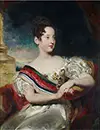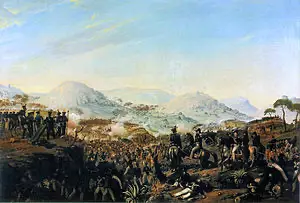Queen Maria II of Portugal
Maria II was Queen of Portugal for more than two decades in the first half of the 19th Century. A succession crisis interrupted her reign. 
She was born on April 4, 1819, at the Palace of São Cristóvão, in Rio de Janiero, Brazil. Her father was the eventual King Pedro IV, and her mother was Maria Leopoldina of Austria. When Maria was born, the King of Portugal was John VI, who was still in Brazil, having fled there in 1807 in the wake of an invasion by France and Spain. Pedro was John's oldest living son and was technically the heir to the Portuguese throne. However, John had appointed Pedro's daughter Maria to succeed him. Lurking as well in the succession mix was John's second-oldest son, Miguel, who had led more than one uprising against his father and had gotten himself exiled to Austria. The people of Portugal made it clear that they did not want a monarch again ruling over both Brazil and Portugal and so Pedro agreed to take the throne but then give it up. John VI died on March 10, 1826, and Pedro became King of Portugal on that day. He abdicated on May 2 of that same year, and his sister became Queen Maria II. Because she was only 7, her uncle Miguel served as regent. John's grand plan had Maria and Miguel eventually marrying and ruling together. While Maria was in Vienna to pursue an education, Miguel seized the throne, declaring himself king on June 23, 1828. Maria ended up with France, where she was reunited with her father and stayed with the French king, Louis Philippe. 
Pedro marshaled support (including one of France's national heroes and a strong friend of the cause of American independence, the Marquis de Lafayette) for Maria's return to the throne and led an army in an invasion of Portugal in July 1832. Pedro's troops, supported by troops from the U.K., landed in Porto and took the city unopposed. Miguel's troops took up siege positions around the city's perimeter. After a year of stalemate, Pedro authorized a risky mission to to the Algarve; it was successful, and his forces drove onward, taking Lisbon on July 24, 1833. At this point, a struggle in Spain spilled over the border. Isabella II who was defending her throne in the first of three Carlist Wars against her uncle, Don Carlos, who was also Pedro's uncle. The erstwhile Brazilian emperor threw in his lot with his cousin, not his uncle, and thereby gained an ally in the Spanish forces loyal to Isabella II. The result was a victory for Isabella and Maria. 
Miguel abdicated on May 26, 1834, and Maria retook the throne. She was still only 15. She got married, to Auguste, Duke of Leuchtenberg, on Jan. 26, 1835. He was 15 at the time. The marriage was extremely short-lived because August died two months later. The following year, Maria married again, this time wedding Prince Ferdinand of Saxe-Coburg and Gotha. The royal couple had 11 children, seven of whom lived into adulthood: Pedro (1837), Luís (1838), João (1842), Maria Ana (1843), Antónia (1845), Fernando (1846), and Augusto (1847). For the first decade of her second reign, Maria enjoyed relative peace across the realm, as the people and government rebuilt and prospered. More roads crisscrossed the country, and the first railroad arrived. Her army put down a revolt in 1846, two years before revolutions convulsed other countries in Europe. In his brief time on the throne, Pedro presided over the introduction of the Carta, a new governmental blueprint, supplanting the Constitution of 1822. The Carta called for a two-house Parliament: an upper chamber in the style of the United Kingdom's House of Lords and a lower house of representatives, the membership of which was split between being elected by the people and being appointed by the king. An 1852 update known as the Additional Act kept the peace. Maria struggled more and more with pregnancy with each child she had. After the birth of Augusto, in 1849, she gave birth to two stillborn children and suffered one miscarriage. She was giving birth to her 11th child when she died, on Nov. 15, 1853. She was 34. Her oldest son became King Pedro V.
|
|
Social Studies for Kids
copyright 2002–2025
David White




